|
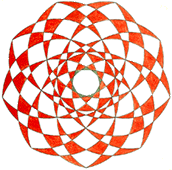
|
Remo F. Roth
Dr. oec. publ., Ph.D.
dipl. analyt. Psychologe (M.-L. v. Franz)
|
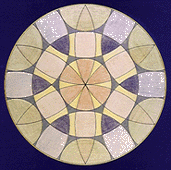
|
© 2002-2004
by Pro Litteris, Zurich, Switzerland and Remo F. Roth, Horgen-Zurich. All Rights
Reserved. dr.remo.roth@psychovision.ch.
Republication and redissemination of the contents of this screen or any part of
this website are expressly prohibited without prior psychovision.ch written
consent.
© copyright for the
"Buddha-like sketch" (W. Pauli) by Tom Kelder
With many thanks to Gregory
Sova, Ph.D. (LA, CA) for the help with the
translation
Book Project:
THE RETURN OF THE WORLD SOUL
Wolfgang Pauli, Carl Jung and the Challenge
of the Unified Psychophysical Reality
© copyright 2002-2004 by
Pro Litteris, Zürich. All rights reserved
This book is
intended for private use only, and is copyrighted under existing Internet
copyright laws and regulations.
back
to Chapter
1 (will
follow)
2. Wolfgang
Pauli's Fludd/flood Synchronicity and the Future Development of
Psychophysical Research
Contents:
2.1. The
Fludd/flood synchronicity
2.2. Pauli’s
interpretation of the pouring out of water
2.3. Wolfgang
Pauli’s Kepler/Fludd essay of 1952
2.4. The meaning
of the Fludd/flood synchronicity
2.4.1
The necessity of the solution of the psycho-physical
problem
2.4.2
Returning to the findings of the hermetic alchemist Robert Fludd
on a higher scientific level
2.4.3 The
solution of the problem of the psychokinetic Pauli effect by
extending the synchronicity concept
2.4.4 The
inclusion of the yang/yin bipolarity of the energetic
principle
2.4.5
Summary
2. Wolfgang Pauli's Fludd/flood
Synchronicity and the Future Development of Psychophysical
Research
2.1. The Fludd/flood
synchronicity
In December of the year 1947 Carl G. Jung
wrote a letter to Wolfgang Pauli in which he asked him to be a
scientific patron of a C.G. Jung Institute, planed to be founded by
students of him. Pauli agreed with this proposal and wrote
back:
"The way your research and
alchemy coincide is to me serious evidence that what is developing
is indicative of a close fusion of psychology with the
scientific experience of the processes in the material physical
world." [Meier, 2001, p. 32; emphasis mine]
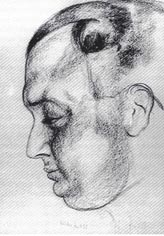 Like Carl Jung, Wolfgang Pauli always thought
that depth psychology is not a branch of humanistic, but of natural
science. In a later letter he writes: Like Carl Jung, Wolfgang Pauli always thought
that depth psychology is not a branch of humanistic, but of natural
science. In a later letter he writes:
"I
should like to point out that psychology always used to be counted as one of
the humanistic sciences, but it was precisely C.G. Jung himself
who emphasized the scientific nature of his ideas, and it was through his
works that
the way was paved for an integration of the psychology of the unconscious into
the natural sciences." [Meier, 2001, p. 212]
Wolfgang Pauli's promise of becoming a
scientific patron of the new institute was obviously guided by the
desire that Jungian psychology should not only be an empirical
science but also be integrated into the strong (mathematical) empiry
of physics. But as I described in Wolfgang
Pauli and Parapsychology (part 2),
in 1953 - after a heavy battle with Marie-Louise von Franz - he
relativated this "occupation" of depth psychology by physics and
replaced it by the demand for a reunion of physics with
parapsychology.
In the letter of 1947 Pauli also talks of a
new project. He writes that his
"attention is focused
strongly on the influence of archetypal concepts ... on scientific
definitions"
and that he will demonstrate this with the
dispute between Johannes Kepler and a hermetic alchemist of those
days, Robert Fludd, which was
"the collision
between the magic-alchemistic and the (new in the 17th century)
scientific way of thinking".
Then he adds that this was
"a collision that I
believe recurs on a higher level in the unconscious of modern
man".
Pauli's occupation with this dispute between
the alchemist and the co-founder of modern quantitative science began
in 1940 and increased with a dream in 1946. In this dream he was
confronted with the fact that he was accused of the "objectivation of
rotation" [Meier, p. 30-2]. We will deal with this dream later, after we have
understood what this term means in a symbolic language. Of course it reminds us
immediately of one of Pauli's most important inventions, the spin.
In April 24, 1948 the foundation of the
C.G. Jung institute took place. When Pauli entered the room, a so-called
Pauli effect occurred. Without any outer cause a Chinese
vase fell onto the floor and the water poured out, resulting in a
flood. Symbolically seen, we can say that this psychokinetic event
was a Chinese water flood.
On the other hand, we have seen that Pauli
had begun to deal with the hermetic alchemist Robert
Fludd, who wrote his name in Latin as Robertus de
Fluctibus. Therefore, we can conclude that these two events belong to
a synchronicity, the psychic (inner) event of it consisting in the
tension in Pauli concerning the dispute between Johannes Kepler and
Robert Fludd, the physical (outer) event in this strange
psychokinetic anomaly, the Pauli effect of the overturned vase,
resulting in a flood.
This synchronicity contains a great deal of
meaning which will be treated in the following sections and
interpreted in the subsequent chapters [partly published on the
internet]. The
first meaning is obvious: the
similarity of the water flood of the overturned vase with the name of
Robert Fludd. Therefore, we must find the common content of
Fludd’s work and the symbol of a water flood. Symbolically seen
we can say that the meaning of this flood is as follows: An
archetypal conception which has a lot to do with "watery"
and "being liquid", which was still living in
Fludd’s hermetic alchemy, but repressed after Johannes Kepler, wishes to be integrated in the new Zeitgeist of the 21st
century .
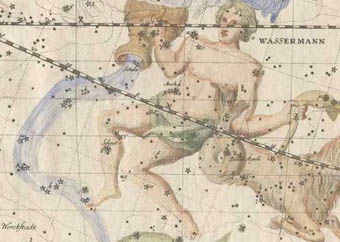 That
this synchronicity has to do with the new age of the Aquarius shows
the following detail: In a late letter, Carl Jung mentions that the
astrological symbol of this new age is a man who pours water out of a
vase...! Therefore, we can conclude that the Fludd/flood
synchronicity could show us some new principles we have to introduce
for the explanation of the highly strange and alien events of the
near future, which we can neither understand with the help of modern
science nor with depth psychology of the 20th century. That
this synchronicity has to do with the new age of the Aquarius shows
the following detail: In a late letter, Carl Jung mentions that the
astrological symbol of this new age is a man who pours water out of a
vase...! Therefore, we can conclude that the Fludd/flood
synchronicity could show us some new principles we have to introduce
for the explanation of the highly strange and alien events of the
near future, which we can neither understand with the help of modern
science nor with depth psychology of the 20th century.
According to Carl Jung we should find out the
meaning of such a synchronicity to obtain new conscious knowledge
about the constellated archetype and the preconscious knowledge
behind it, which will tell us what the real intentions of the Self,
the center of the collective unconscious are. Because this
synchronicity happened at the founding ceremony of the new institute
and it had been founded for scientific research and the training of
Jungian psychotherapists, it is obvious that the
synchronicity’s meaning has to do with future scientific
challenges of the C.G. Jung Institute.
2.2.
Pauli’s interpretation of the pouring out of
water
Before we go on with the interpretation of
this synchronicity, we will ask ourselves how Pauli interpreted it.
In a letter of June 16, 1948 he writes to Jung:
"When that amusing
‘Pauli effect’ of the overturned vase occurred, on the
occasion of the founding of the Jung Institute, I had the
immediate and vivid impression that I should ‘pour out
water inside’ [‘innen Wasser
ausgiessen’] (- to use the symbolic language that I have
acquired from you). Then when the connection between
psychology and physics took up a relatively large part of your
talk, it became even more clear to me what I was to do.
The outcome of all this is the enclosed essay." [emphasis mine]
The mentioned enclosure was an essay with the
title Moderne Beispiele zur ‘Hintergrunds-physik’
(Modern Examples of ‘Background Physics’).
[My most recent research results (Aug 2006) about this subject see in Background Physics and the Psychophysical Reality]
In it
Pauli deals with the fact of "the appearance of quantitative
terms and concepts from physics in spontaneous fantasies [and
dreams; RFR] in a qualitative and figurative - i.e., symbolic -
sense", which began in 1935 or 1936. First they appeared shocking to
his rational mind, as "an abuse of scientific
terminology". But then he continues:
"Later, however, I
came to recognize the objective nature of these dreams or
fantasies ... Thus it was that I gradually came to
acknowledge that such fantasies or dreams are neither meaningless
nor purely arbitrary but rather convey a sort of
‘second meaning’ of the terms applied."
[emphasis mine]
And he concludes, that
"the purely
psychological interpretation only apprehends half of the matter.
The other half is the revealing of the archetypal basis of the
terms actually applied in modern physics. What the final
[teleological; RFR] method of observation must see in the
production of ‘background physics’ through the
unconscious of modern man is a directing of objective toward
a future description of nature that uniformly comprises
physis and psyche, a form of description that at the
moment we are experiencing only in a prescientific phase. To
achieve such a uniform description of nature, it appears to
be essential to have recourse to the archetypal background of the
scientific terms and concepts." [emphasis mine]
As Pauli also writes, the beginning of such a
reunion is the formulation of a so-called "neutral
language" which comprises both sciences, physics and depth psychology.
These introductory words of the Background
Physics show us, how Pauli interpreted the symbolic term "pouring out water inside":
He allowed himself to quit the pure rational interpretation of physical terms
and replace it by a
symbolic understanding of them.
Later - in a letter to Marie-Louise von Franz
from July 18, 1954 - he describes this project a bit more exactly:
Neither the physical language - the first one - nor the
psychological - the second one - is good enough. Therefore the
unconscious speaks in a physical-symbolic language (a third one)
which we must transform into a "neutral language", that can be
understood by the rational consciousness. To my mind, finding this
fourth, the neutral language, will be the challenge of the beginning
21st century.
We can summarize Pauli’s
intention, derived from his psychokinetic Pauli effect at the
foundation assembly of the C.G. Jung Institute, as follows: The
symbolic term "pouring out water" means to open up the
rational mind for the purpose of finding a neutral language which -
with the help of quasi-physical terms - describes processes in a
world behind or beyond physics and depth psychology, in a
world that Pauli later defined as the "unified psychophysical
reality".
2.3. Wolfgang
Pauli’s Kepler/Fludd essay of 1952
When we look back to Pauli’s conscious
reasons for writing the Background Physics, we see that his
occupation with Robert Fludd, which increased with the dream about
the "objectivation of the rotation", did not play an important
role. Therefore, it seems that Pauli, in 1948, did not stress the
fact enough that the flood of the Chinese vase had also to do with
his occupation concerning the dispute between Johannes Kepler and
Robert Fludd.
But we know that Pauli - two and a half years
after this synchronicity - wrote (on Dec. 25, 1950) to Markus Fierz
that he believes
"that I carry
‘Kepler’ as well as ‘Fludd’ in myself and that
it is for me a necessity to arrive at a synthesis of this pair of
opposites, as best I can" [Enz, 2002].
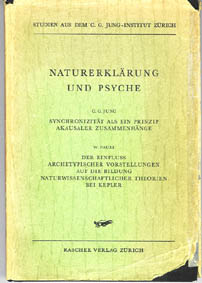 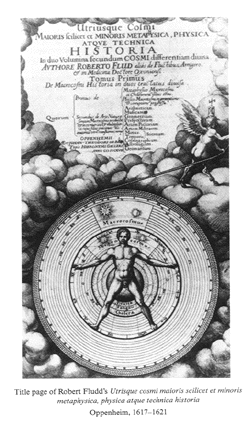 We
know, too, that he went on dealing with this extreme tension at the
beginning of the 17th century, where quantitative science began to
supersede the archaistic-magic world view of the alchemy of the
Middle Ages. The result was an article with the title Der Einfluss
archetypischer Vorstellungen auf die Bildung naturwissenschaftlicher
Theorien bei Kepler (The Influence of Archetypal Ideas on the
Scientific Theories of Kepler [Pauli, 1994, pp. 219-79) which
he published in the year 1952, together with Carl Jung’s article
Synchronizität als ein Prinzip akausaler
Zusammenhänge (Engl. transl. in CW 8) in the book
Naturerklärung und Psyche (The Interpretation of
Nature and Psyche) . We
know, too, that he went on dealing with this extreme tension at the
beginning of the 17th century, where quantitative science began to
supersede the archaistic-magic world view of the alchemy of the
Middle Ages. The result was an article with the title Der Einfluss
archetypischer Vorstellungen auf die Bildung naturwissenschaftlicher
Theorien bei Kepler (The Influence of Archetypal Ideas on the
Scientific Theories of Kepler [Pauli, 1994, pp. 219-79) which
he published in the year 1952, together with Carl Jung’s article
Synchronizität als ein Prinzip akausaler
Zusammenhänge (Engl. transl. in CW 8) in the book
Naturerklärung und Psyche (The Interpretation of
Nature and Psyche) .
Today, in scientific circles this article is
called the Kepler essay (Keplerstudie or Keplerartikel). But when we
read it, we see that it has at least as much to do with Robert Fludd;
if we include the appendices, we see that Wolfgang Pauli wrote 48 of
the total 84 pages (pp. 147-194) about the latter and his alchemical
philosophy.
Therefore we can conclude, that Pauli tried
to find the above mentioned synthesis of Kepler and Fludd in himself
in this article. If he succeeded or not we will see later on.
2.4. The meaning of
the Fludd/flood synchronicity
2.4.1 The
necessity of the solution of the psychophysical problem
As we have seen, the reason why Pauli
accepted to be a patron of the new institute, was his belief "that what is developing is indicative of a close fusion of
psychology with the scientific experience of the processes in the
material physical world". Moreover, some months later, in the
foundation speech of Carl Jung "the connection between
psychology and physics took up a relatively large part". Therefore a second
meaning of the Fludd/flood
synchronicity is the need of scientific research for the
solution of the so-called psychophysical problem.
With the repression of the anima
mundi, the world soul of medieval world view, which was the
unifying ligament between matter and psyche, the problem arouse,
that
this connection was not defined anymore. For the explanation of this "missing link" Leibnitz and Spinoza invented the so called
"psychophysical parallelity". In a disparaging manner Pauli
called this idea "a mental nebula" ("ein geistiger
Nebelfleck"). He argued that in a deterministic world it must be
possible to explain this relation in a causal way, too, and by this
the obscure parallelity would not be necessary anymore. But if we do
not believe in a causal relationship it would be better to look for a
synchronistic connection.
2.4.2 Returning to the
findings of the Hermetic alchemist Robert Fludd on a higher
scientific level
In Robert Fludd’s hermetic alchemy the
world soul, the anima mundi, was still the vinculum
amoris (ligament of love) of matter and spirit. Thus, we can
already conclude that a third
meaning of Pauli’s
synchronicity is the challenge of going back behind Kepler to
Robert Fludd with the goal of finding a new synthesis of the
divine male principle with the female.
This task will culminate in the reunion of
the quantitative description of nature - which began with Kepler (and
before him with Galileo Galilei) - with the qualitative-symbolic of Robert
Fludd. Of course, today, this can only be done with the help of an
inclusion of the results of modern science, especially of quantum
physics and depth psychology, and it has nothing to do
with a regression into the pre-scientific world of New Age
philosophy.
As we will see, this can, in my opinion, be
done only with a new theory which is a reunion of quantum physical
theory and depth psychological experience, and which also includes
the explanation of parapsychological facts, such as telepathy and
psychokinesis. Furthermore, this reunion should take place in the
background of the unified psychophysical reality (the unus
mundus), Wolfgang Pauli and Carl Jung looked for but could not
yet describe in a scientific language.
2.4.3 The solution of
the problem of the psychokinetic Pauli effect by extending the
synchronicity concept
The vase fell to the floor without any
external cause when Pauli entered the room. Therefore we must
conclude that at the beginning of the foundation ceremony of the C.G.
Jung Institute a so-called Pauli effect happened.
As many of his colleagues confirmed, Pauli
was surrounded by a mysterious aura which seemed to belong to strange
psychokinetic events in his surrounding. For example, when he entered
the laboratory of his colleague Otto Stern in Hamburg, many times
the physical experiments broke down and the apparatus exploded [Enz, 2002].
In February 1950, when he was at Princeton, the cyclotron burnt, and he felt
that this mischief belonged to such an
effect, named after him. Markus Fierz, his colleague who had a very
intimate knowledge of him, explained, that Pauli himself believed in
this psychokinetic effect. Pauli told him
"that he senses the
mischief already before as a disagreeable tension, and when the
anticipated misfortune then actually hits - another one! - he
feels strangely liberated and lightened." [Enz,
2002]
When we include this fact into the context of
the Fludd/flood synchronicity, it will show us a fourth
meaning: Future research
should also deal with this psychokinetic aspect of physical
anomalies.
This aspect is especially important as it
concerns the principle of synchronicity, defined by Carl Jung. He
and, especially, his student and my teacher Marie-Louise
von Franz, stressed continuously,
that the connection between the two events of synchronicity is one of
meaning - which means also one of psychic energy - and cannot be one
of physical energy exchange, because with such an assumption we would
regress into the world of magic causality: We argue causally (cause
and effect) but do not know any causal laws concerning this process.
But the Pauli effect must have something to do with both energies,
because it is obvious that in it psychic energy is transformed into
physical. Therefore the fourth meaning of the Fludd/flood
synchronicity contains the idea that the concept
of Jung’s
synchronicity itself should be extended.
2.4.4 The inclusion of
the yang/yin bipolarity of the energetic
principle
The vase which fell to the floor was Chinese.
We know that Pauli dealt intensely with Taoism, where the union of
the two energetic principles of yin and yang in the moment of the Tao
plays an extremely important role. The fifth
meaning of the Fludd/flood
synchronicity is therefore the inclusion of energy’s
yang/yin bipolarity into a new scientific view of
life.
2.4.5
Summary
When we summarize the above meaning of
Wolfgang Pauli’s Fludd/flood synchronicity we obtain the
following results:
|
The C.G. Jung Institute,
founded in 1948, would have had the challenge of scientific
research with regard to the topic of the union of modern
physics with depth psychology Wolfgang Pauli and Carl Jung
looked for.
The
content of this research should be an extended view of synchronicity,
which - on the
bases of symbolically extended quantum physical concepts -
includes telepathy and psychokinesis as well. The hypothesis
of the unified psychophysical reality should be the
background for the explanation of these phenomena as well as a new scientific
interpretation of the energy principle as a "fluid" or "watery" yang/yin
bipolarity.
|
Bibliography:
Enz, Charles, P., No Time to be
Brief, A scientific biography of Wolfgang Pauli, Oxford
University Press, Oxford, 2002
Jung, C.G., Collected Works, vol.
8, Princeton University Press, 1969
Jung, C.G., Pauli, W.,
Naturerklärung und Psyche, Rascher Verlag, Zürich,
1952
Jung, C.G., Pauli, W., The
Interpretation of Nature and Psyche, Bollingen Series LI,
Pantheon Books, N.Y., 1955
Meier, C.A., (ed.), Atom and
Archetype, The Pauli/Jung Letters 1932-1958, Princeton University
Press, New Jersey, 2001
Pauli, Wolfgang,
Wissenschaftlicher Briefwechsel mit Bohr, Einstein, Heisenberg,
u.a, ed. Karl v. Meyenn, vol. 2, Springer, Berlin,
1985
Pauli, Wolfgang,
Wissenschaftlicher Briefwechsel mit Bohr, Einstein, Heisenberg,
u.a, ed. Karl v. Meyenn, vol. 3, Springer, Berlin,
1993
Pauli, Wolfgang, Writings on
Physics and Philosophy, ed. Charles P. Enz and Karl von Meyenn,
Springer, Berlin, 1994
Pauli, Wolfgang,
Wissenschaftlicher Briefwechsel mit Bohr, Einstein, Heisenberg,
u.a, ed. Karl v. Meyenn, vol. 4/I, Springer, Berlin,
1996
Pauli, Wolfgang,
Wissenschaftlicher Briefwechsel mit Bohr, Einstein, Heisenberg,
u.a, ed. Karl v. Meyenn, vol. 4/II, Springer, Berlin,
1999
Pauli, Wolfgang,
Wissenschaftlicher Briefwechsel mit Bohr, Einstein, Heisenberg,
u.a, ed. Karl v. Meyenn, vol. 4/III, Springer, Berlin,
2001
proofread GJS, Aug. 2003
Chapter
3, part 1
See also further articles about Wolfgang Pauli in
http://www.psychovision.ch/rfr/roth_e.htm
See also
Wikipedia article Psychophysisches
Problem
back

15.10.2002
|